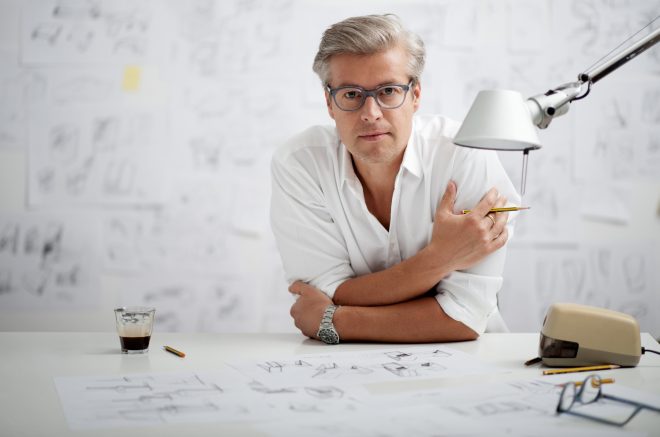With STUDIO, Thomas Feichtner has developed a modern, modular workplace system, designed to appeal particularly to people who live their individuality and creativity, even at work. We spoke to him about design in the workplace, creative currency and his childhood dream job.
WHAT INSPIRED YOU TO CREATE STUDIO?
Lots of my colleagues often put their own furniture together because they couldn’t find what they wanted on the conventional office furnishings market. That was my starting point. And then I just asked myself: “What furniture would I love to have in my own office?”
WHAT MARKS YOUR TARGET AUDIENCE, THE PEOPLE YOU DESIGNED STUDIO BY BENE FOR?
Creatives don’t see boundaries between work and private life, work and leisure. They’re not concerned with work-life-balance, just about “love your work”. And this group includes lots of design lovers who want to have beautiful things at home and in the office. So the dividing line between home and office is fluid. You want to feel at home.
WHY DID YOU CHOOSE THIS MIX OF COLOURS AND MATERIALS FOR STUDIO?
The colours are chosen to harmonise together. My favourite is the simple white. It’s the details that make it special: all the panels have mitred joints. Bene brings a level of quality that you normally only find in handcrafted carpentry to serially produced furniture for the first time.
WHAT DOES GOOD DESIGN AT OUR WORKPLACE CREATE?
Social media means that friends and family are with us every day, even in the office. In return, we might still be reading work emails at midnight. We don’t necessarily always work at our workplace any more. This is a development that office furniture also needs to take into account. It means that a workplace isn’t necessarily just “that one desk”, but more an area. It needs to match the quality of all other parts of our life.
WHAT MAKES UP A TYPICAL THOMAS FEICHTNER DESIGN?
I see design as fundamentally a piece of autonomy. In an age when we’re all woken by the same ring tone on the same mobile, and use the same software on our computers, it’s time for alternatives. Design is an alternative, it’s love for things. The key to an idea. The joy in an idea that jumps like a spark. Design can be surprising, sophisticated and witty. That’s what I want to convey.
IF STUDIO WERE A PERSON, HOW WOULD YOU DESCRIBE THEM IN 3 WORDS?
Honest, uncomplicated, individual.
WHAT DO YOU NEED TO LIVE OUT YOUR CREATIVITY?
Pencil, sharpener and paper.
IS IDENTITY THE CURRENCY OF CREATIVES?
Yes. The globalisation of information and aesthetics forces designers to think beyond the aesthetic appearance of a product, consider more complex contexts and act strategically to create identities. Future design commissions won’t be judged only on their cultural, social or economic relevance, but also on the extent to which they can think critically and interact politically.
STUDIO HAS A VERY CLEAR FORMAL LANGUAGE, ESPECIALLY THE SWING TABLE. HOW DID THAT COME ABOUT?
I wanted to avoid the tables looking like heavy, stationary machinery. As a contrast to the “double” table top, I wanted the legs to be as light as possible, yet very stable. Inspired by the “tree” yoga position, the Swing framework channels the static energy back into the table legs.

WORD WRAPS
WHICH FILM MOVES YOU?
History docs.
YOUR FAVOURITE SONG DURING THE CREATIVE PROCESS?
Sorry, but I need peace and quiet.
SAILING OR MOUNTAIN HIKE?
Mountain hike with my family and dog.
WORK STYLE OR LIFESTYLE?
Work style is lifestyle.
WHAT BOOK IS ON YOUR BEDSIDE TABLE?
Architectural Digest.
YOUR DREAM JOB AS A CHILD?
Graphic novellist.
WHAT DO YOU DO TO RECHARGE?
Go for a walk.


